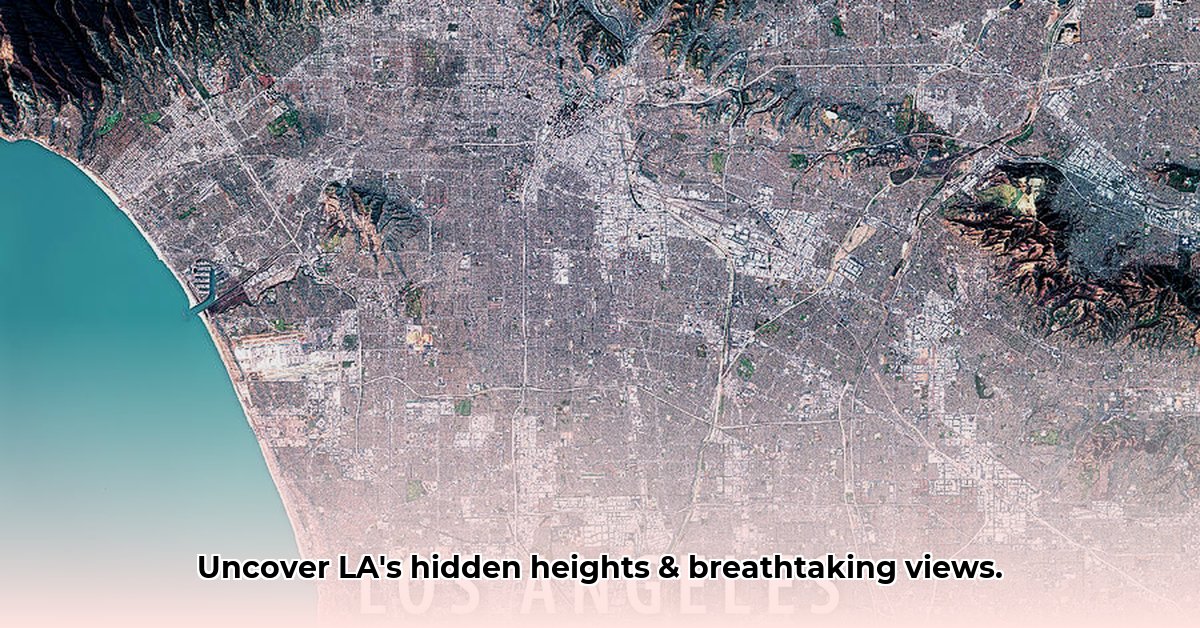
Los Angeles: a city of dramatic contrasts, where the sun-drenched beaches meet the towering peaks of the San Gabriel Mountains. This isn't just a picturesque backdrop; LA's wildly varying elevation profoundly impacts its climate, development, recreational opportunities, and even the risks its residents face. For precise elevation data, check out this helpful resource: LA elevation data. This guide unravels the city's vertical landscape, offering actionable insights for residents, tourists, and professionals alike.
Exploring LA's Ups and Downs: From Beaches to Mountaintops
Los Angeles' elevation is far from uniform; it's a breathtaking tapestry of heights and depths. This diverse topography creates distinct microclimates and shapes everything from the architecture of our homes to the weather we experience. Let's delve into the details.
Neighborhood Heights: A Bird's-Eye View
The city's elevation varies significantly, creating unique neighborhood characters. Downtown LA, for instance, sits around 300 feet above sea level, offering a distinct contrast to the oceanfront communities of Santa Monica, practically at sea level. The Hollywood Hills and Westside rise to elevations between 200 and 500 feet, providing spectacular panoramic views. Venture into the San Fernando Valley, and you'll find yourself around 1000 feet above sea level. Finally, the majestic San Gabriel Mountains soar to well over 5,000 feet, offering a completely different perspective.
| Neighborhood | Approximate Elevation (feet) | Typical Climate & Feel | Notable Features |
|---|---|---|---|
| Santa Monica | 0-100 | Cool breezes, mild temperatures year-round, sunny skies | Beachfront living, laid-back atmosphere |
| Downtown Los Angeles | ~300 | Moderate temperatures, urban heat island effect | Skyscrapers, bustling city life |
| Hollywood Hills | 200-500 | Mild to warm days, cooler nights, potential temperature inversions | Luxurious homes, stunning city views, winding roads |
| San Fernando Valley | ~1000 | Warmer days, cooler nights, more significant temperature swings | Suburban sprawl, family-friendly atmosphere |
| San Gabriel Mountains | 5,000+ | Significantly cooler, potential for snow in winter | Hiking trails, stunning views, wildlife viewing opportunities |
This table provides a general overview. More detailed elevation data is readily available through various online mapping services and local government resources.
How Altitude Affects LA's Weather: Microclimates in Action
Elevation significantly impacts LA's weather. The higher the altitude, the cooler the temperature. Mountain communities often experience chilly mornings and even winter snowfall, a stark contrast to the consistently warm coastal areas. This creates diverse microclimates, each with its own unique characteristics. Driving a short distance can result in a dramatic shift in temperature and weather patterns. Isn't it fascinating how much the weather can change just by changing your elevation?
Building LA: How Elevation Shapes Our City
LA's topography has profoundly influenced its urban development. Flatter areas like Downtown accommodate skyscrapers, maximizing space on stable ground. Hillside areas, however, present unique challenges. Homes are built clinging to slopes, creating a stunning yet sometimes precarious urban landscape. This uneven terrain affects not only architecture but also road construction, water management, and overall accessibility.
LA's Geological History: A Story Etched in Stone (and Some Risk)
Millions of years of geological activity have shaped LA's landscape. This history, while beautiful, presents inherent risks. Hillside communities, for example, are vulnerable to landslides due to unstable slopes. Wildfires are another significant concern, particularly in higher elevation areas prone to drier conditions. Awareness of these risks is critical for residents and visitors alike. How does understanding LA's geological history inform our approach to safety and preparedness?
Recreation in LA: From Sun-Kissed Beaches to Mountain Peaks
LA's diverse elevation offers a wide array of recreational opportunities. From surfing at sea level to hiking in the mountains, the city provides a diverse playground. You can enjoy a variety of activities all within a relatively short distance, making it a unique and dynamic recreational landscape. How does LA's varied topography enhance its appeal as a recreational destination?
Understanding Elevation's Impact: Actionable Insights
Understanding elevation's influence provides valuable insights for various stakeholders:
Urban Planners: Elevation data is essential for planning new developments and infrastructure, taking into account weather patterns and potential hazards.
Emergency Responders: Knowledge of elevation is vital for efficient emergency response, particularly during wildfires, earthquakes, and landslides, ensuring optimal resource allocation and evacuation planning.
Real Estate Professionals: Highlighting elevation's benefits (stunning views, unique microclimates) is key to effective property marketing.
Tourism: Develop itineraries showcasing LA's elevation diversity, offering a range of activities and experiences.
Environmental Agencies: Monitoring higher elevations and potential hazards like wildfires and erosion is vital for protecting the environment and public safety.
How to Find Los Angeles Property Elevation Data for Real Estate
Precise elevation data is crucial for informed real estate decisions. Several resources provide this information:
County Assessor's Website: The Los Angeles County Assessor's website (https://portal.assessor.lacounty.gov/mapsearch) often contains parcel maps with elevation data.
Online Mapping Services: Google Earth Pro or ArcGIS Online offer detailed topographic maps with elevation readings.
Specialized GIS Data: High-resolution elevation data is available through GIS databases, requiring subscriptions and software expertise.
Real Estate Professionals: Local agents often have access to databases containing elevation information.
Conclusion
Los Angeles' dramatic elevation changes significantly impact its character and daily life. Understanding this vertical dimension fosters a deeper appreciation for the city's beauty, challenges, and immense diversity. By leveraging readily available resources and information, we can better navigate and appreciate this unique urban landscape.